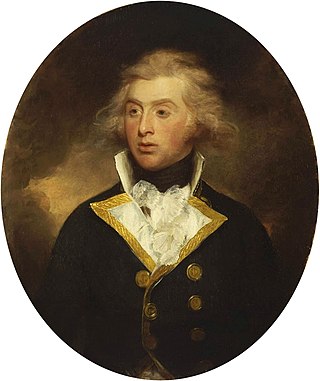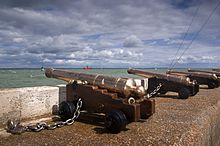
A navy, naval force, or maritime force is the branch of a nation's armed forces principally designated for naval and amphibious warfare; namely, lake-borne, riverine, littoral, or ocean-borne combat operations and related functions. It includes anything conducted by surface ships, amphibious ships, submarines, and seaborne aviation, as well as ancillary support, communications, training, and other fields. The strategic offensive role of a navy is projection of force into areas beyond a country's shores. The strategic defensive purpose of a navy is to frustrate seaborne projection-of-force by enemies. The strategic task of the navy also may incorporate nuclear deterrence by use of submarine-launched ballistic missiles. Naval operations can be broadly divided between riverine and littoral applications, open-ocean applications, and something in between, although these distinctions are more about strategic scope than tactical or operational division.

USS Pennsylvania was a three-decked ship of the line of the United States Navy, rated at 130 guns, and named for the state of Pennsylvania. She was the largest United States sailing warship ever built, the equivalent of a first-rate of the British Royal Navy. Authorized in 1816 and launched in 1837, her only cruise was a single trip from Delaware Bay through Chesapeake Bay to the Norfolk Navy Yard. The ship became a receiving ship, and during the Civil War was destroyed.

HMS Duke of Wellington was a 131-gun first-rate ship of the line of the Royal Navy. Launched in 1852, she was symptomatic of an era of rapid technological change in the navy, being powered both by sail and steam. An early steam-powered ship, she was still fitted with towering masts and trim square-set yards, and was the flagship of Sir Charles Napier.

The third and current HMS Argyll is a Type 23 Duke-class frigate. She is currently the oldest serving Type 23 frigate in the Royal Navy. Like all of her class she is named after a British dukedom, in this case that of Argyll. HMS Argyll was laid down in March 1987 by Yarrow Shipbuilders at Glasgow, and launched in 1989 by Lady Wendy Levene, sponsored by the Worshipful Company of Paviors. She was commissioned in May 1991. Argyll is currently based at HMNB Devonport.

HMS Northumberland is a Type 23 frigate of the Royal Navy. She is named after the Duke of Northumberland. She is the eighth RN ship to bear the name since the first 70-gun ship of the line in 1679, and the ninth in the class of Type 23 frigates. She is based at Devonport and is part of the Devonport Flotilla.

The rating system of the Royal Navy and its predecessors was used by the Royal Navy between the beginning of the 17th century and the middle of the 19th century to categorise sailing warships, initially classing them according to their assigned complement of men, and later according to the number of their carriage-mounted guns. The rating system of the Royal Navy formally came to an end in the late 19th century by declaration of the Admiralty. The main cause behind this declaration focused on new types of gun, the introduction of steam propulsion and the use of iron and steel armour which made rating ships by the number of guns obsolete.

USS Merrimack, also improperly Merrimac, was a steam frigate, best known as the hull upon which the ironclad warship CSS Virginia was constructed during the American Civil War. The CSS Virginia then took part in the Battle of Hampton Roads in the first engagement between ironclad warships.
HMS Fox was a 32-gun Active-class fifth rate frigate of the Royal Navy. She was launched on 2 June 1780 at Bursledon, Hampshire by George Parsons.

HMS St Lawrence was a 102-gun first-rate wooden warship of the Royal Navy that served on Lake Ontario during the War of 1812. Built on the lake at the Royal Navy dockyard in Kingston, Ontario, she was the only Royal Navy ship of the line ever to be launched and operated entirely in fresh water. Constructed in 1814, the ship's arrival on the lake ended all naval action and St Lawrence finished the war having never gone into battle. Following the war, the vessel was laid up, eventually being sold in 1832 to private interests. The ship was later sunk and is now a recreational dive spot.

Admiral Sir Robert Stopford, was a distinguished officer in the Royal Navy whose career spanned over 60 years, from the French Revolutionary Wars to the Syrian War.

Virginia Water Lake lies on the southern edge of Windsor Great Park, in the borough of Runnymede in Surrey and the civil parishes of Old Windsor and Sunningdale in Berkshire, in England. It is a man-made lake taking its name from a natural body of water of the same name. There is a village of Virginia Water which stretches out to the east of the lake. The grounds of the lake, nearby Fort Belvedere, and the Clockcase are all Grade I listed on the Register of Historic Parks and Gardens.

HMS Pique was a wooden fifth-rate sailing frigate of the Royal Navy, designed by Sir William Symonds. She was launched on 21 July 1834 at Devonport. The vessel was of 1,633 tons burthen and had 36 guns. She was broken up in 1910.

HMS Alceste was built at Rochefort in 1804 for the French Navy as Minerve, an Armide-class frigate. In the spring of 1806, prior to her capture, she engaged HMS Pallas, then under Lord Cochrane. During the duel she ran aground but Cochrane had to abort his attack when French reinforcements appeared.

His Highness' Ship Glasgow was a royal yacht belonging to the Sultan of Zanzibar. She was built in the style of the British frigate HMS Glasgow which had visited the Sultan in 1873. Glasgow cost the Sultan £32,735 and contained several luxury features but failed to impress the Sultan and she lay at anchor in harbour at Zanzibar Town for much of her career. The vessel was brought out of semi-retirement on 25 August 1896 when she participated in the Anglo-Zanzibar War and was soon sunk by a flotilla of British warships. Glasgow's wreck remained in the harbour, her three masts and funnel projecting from the water, until 1912 when she was broken up for scrap.

The Bittern-class sloop was a three-ship class of long-range escort vessels used in the Second World War by the Royal Navy.

A naval tradition is a tradition that is, or has been, observed in one or more navies.

Cowes Castle, also known as West Cowes Castle, is a Device Fort in Cowes on the Isle of Wight. Originally built by Henry VIII in 1539 to protect England against the threat of invasion from France and the Holy Roman Empire, it comprised a circular bastion, flanking wings and a keep, and in 1547 it housed 17 pieces of artillery. With its companion fortification at East Cowes, the castle overlooked the entrance to the River Medina, an important anchorage. The invasion threat passed but the fortification continued in use until the middle of the 19th century, very briefly seeing action in 1642 during the English Civil War.
Gordon Thomas Falcon was an officer in the Royal Navy. He first went to sea in 1794 as an able seaman on board HMS Sheerness. Quickly promoted to midshipman, Falcon transferred to HMS Repulse and then HMS Venerable, Admiral Adam Duncan's flagship, in which he served at the Battle of Camperdown.
HMS Nymphe was a 38-gun fifth rate frigate of the Royal Navy, launched on 13 April 1812 at Woolwich Dockyard, and commissioned later that month. She was a Lively class of 18-pounder frigates, designed by the Surveyor of the Navy, Sir William Rule. It was probably the most successful British frigate design of the Napoleonic Wars, to which fifteen more sister ships would be ordered between 1803 and 1812.
Israel Pownoll (c.1710–1779) was an English shipbuilder for the Royal Navy.

















